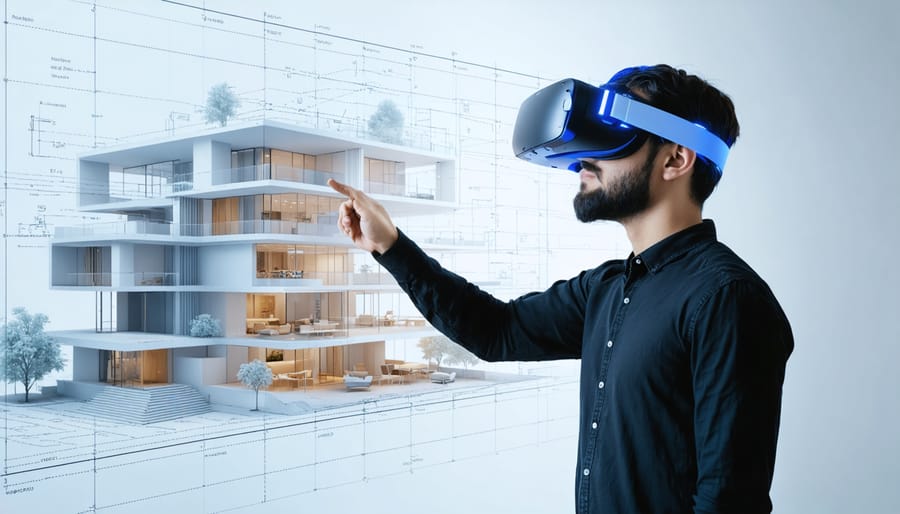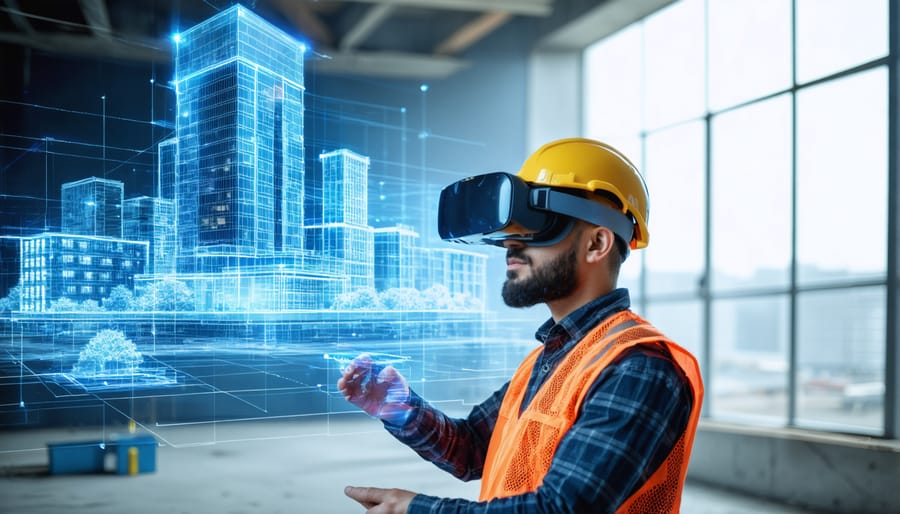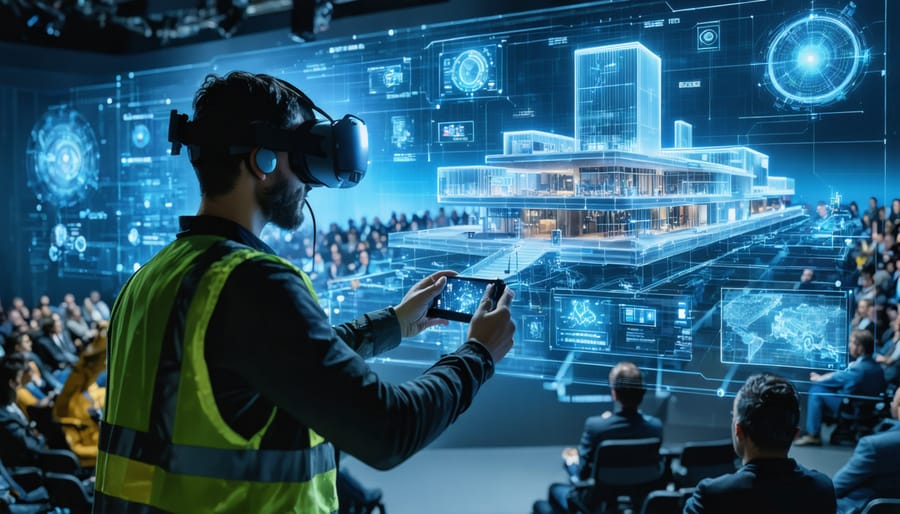Gaming industry events are reshaping the future of architectural visualization and construction technology investments at an unprecedented pace. From Unreal Engine’s breakthrough demonstrations at GDC to Autodesk University’s integration of gaming technologies, these gatherings serve as crucial innovation hubs where construction professionals discover next-generation visualization tools and real-time rendering solutions.
The convergence of gaming and construction technologies at major industry events has accelerated the adoption of virtual reality for project planning, augmented reality for on-site coordination, and advanced simulation platforms for safety training. Leading events like SIGGRAPH and E3 consistently showcase technological advancements that construction firms can leverage to enhance project delivery, improve stakeholder communication, and optimize design workflows.
As gaming engines become increasingly sophisticated, their application in construction visualization has evolved from simple renderings to complex, interactive environments that enable real-time design modifications and collaborative decision-making. This transformation, driven by innovations unveiled at premier gaming events, is fundamentally changing how construction professionals approach project visualization, planning, and execution.
Major Gaming Industry Events Impacting Construction
Game Developers Conference (GDC)
The Game Developers Conference continues to be a pivotal platform where cutting-edge architectural visualization tools and real-time rendering technologies take center stage. Construction professionals increasingly find value in GDC’s presentations of advanced game engines and visualization solutions that are transforming building design and project communication.
Notable developments from recent GDC events include improvements in real-time ray tracing capabilities, which enable architects to create photorealistic renderings with accurate lighting and material properties instantly. These advancements allow for immediate visualization of design changes, significantly streamlining the decision-making process during client presentations and design reviews.
Industry leaders like Epic Games and Unity showcase how their game engines are being adapted for construction applications. These platforms now offer specialized features for architectural visualization, including BIM integration, material libraries specific to construction, and tools for creating interactive virtual walkthroughs of proposed buildings.
Virtual and augmented reality solutions presented at GDC have particular relevance for construction professionals. These technologies enable immersive site inspections, safety training simulations, and collaborative design reviews in virtual environments. The conference has highlighted how VR can reduce costly errors by allowing stakeholders to experience spaces before construction begins.
Cloud-based rendering solutions demonstrated at GDC are particularly noteworthy, as they enable teams to generate high-quality visualizations without substantial hardware investments. This democratization of advanced visualization tools is making sophisticated presentation capabilities accessible to firms of all sizes.
SIGGRAPH
SIGGRAPH stands as a pivotal event where cutting-edge graphics technologies intersect with architectural visualization and construction planning. This annual conference showcases revolutionary rendering techniques, real-time visualization solutions, and advanced modeling tools that are transforming how construction professionals conceptualize and present projects.
Industry leaders consistently demonstrate how technologies originally developed for gaming engines, such as ray tracing and dynamic lighting systems, are being adapted for construction visualization. These innovations enable architects and engineers to create photorealistic representations of buildings before breaking ground, significantly improving client communication and decision-making processes.
Recent SIGGRAPH conferences have highlighted the integration of real-time rendering capabilities with Building Information Modeling (BIM) systems, allowing for instant visualization of design changes. This advancement particularly benefits construction teams during project planning and stakeholder presentations, offering unprecedented levels of detail and interactivity.
Virtual reality and augmented reality applications, prominently featured at SIGGRAPH, are revolutionizing site planning and safety training. Construction firms can now create immersive environments for worker training and project visualization, reducing risks and improving project outcomes.
The conference also serves as a platform for networking between construction technology developers and industry practitioners, fostering collaborations that drive innovation in construction visualization tools. These partnerships have led to specialized solutions that address specific challenges in construction planning and execution.
Virtual Reality and Construction Planning

Immersive Design Reviews
Virtual Reality (VR) tools have emerged as one of the most significant breakthrough construction technologies for architectural design reviews and client presentations. Leading architecture firms are now leveraging gaming engine technology to create immersive, interactive environments that revolutionize how stakeholders experience and evaluate designs before construction begins.
These VR-powered design reviews enable project teams to identify potential issues and optimize spatial layouts with unprecedented accuracy. Architects can guide clients through virtual walkthroughs of proposed buildings, allowing real-time modifications and immediate feedback. This interactive approach has reduced design revision cycles by up to 50% while significantly improving client satisfaction and project outcomes.
The technology allows for detailed examination of crucial elements like lighting conditions, material finishes, and space utilization across different times of day and seasons. Project managers report that VR presentations have dramatically improved stakeholder understanding and decision-making efficiency, particularly for complex architectural features and mechanical systems integration.
Recent case studies demonstrate that VR design reviews have resulted in substantial cost savings by identifying potential construction conflicts early in the design phase. Firms implementing these tools report up to 30% reduction in change orders during construction, highlighting the technology’s practical value beyond its impressive visualization capabilities.
Safety Training Applications
Gaming technology has revolutionized safety training in the construction industry by providing immersive, risk-free environments for workers to practice critical procedures. Virtual reality (VR) simulations, developed using gaming engines like Unreal and Unity, allow construction professionals to experience hazardous scenarios without physical danger.
Leading construction firms have reported up to 70% improvement in safety compliance after implementing game-based training programs. These applications simulate various scenarios, from working at heights to operating heavy machinery, enabling workers to develop muscle memory and decision-making skills in a controlled environment.
Case studies from major construction projects demonstrate the effectiveness of these training tools. For instance, a prominent UK-based contractor reduced workplace incidents by 40% after implementing VR safety training developed from gaming technology. The system allows trainees to practice emergency responses, equipment operation, and safety protocols repeatedly until mastery is achieved.
Real-time physics engines and advanced graphics capabilities borrowed from the gaming industry create highly realistic simulations. These features help workers understand the consequences of their actions without risk, while supervisors can monitor and assess performance through detailed analytics.
The integration of multiplayer functionality enables team-based scenarios, essential for coordinating emergency responses and collaborative tasks. This approach has proven particularly valuable for training crane operators, scaffolding teams, and personnel involved in complex installation procedures.
Real-Time Rendering in Architecture
Unreal Engine Applications
Leading architectural firms are increasingly adopting Unreal Engine for advanced visualization capabilities, transforming how projects are conceived and presented. HOK, a global design firm, implemented Unreal Engine to create immersive walkthroughs for their healthcare facility designs, resulting in a 40% reduction in client revision requests and improved stakeholder engagement.
Foster + Partners leverages Unreal Engine’s real-time rendering capabilities for sustainable design visualization, enabling instant material and lighting adjustments during client presentations. Their London headquarters project showcased how gaming technology could streamline the design review process, cutting visualization time by 60%.
Gensler’s implementation of Unreal Engine for their mixed-use development projects demonstrates the platform’s versatility. Their teams utilize the engine’s advanced physics simulation to analyze natural lighting patterns and pedestrian flow, contributing to more informed design decisions. The firm reports a 30% improvement in client communication effectiveness when using real-time visualization tools.
These case studies highlight how gaming engine technology has evolved beyond entertainment, becoming an essential tool for architectural visualization and design validation. The integration of these tools has significantly reduced the gap between conceptual design and final construction outcomes.

Unity in Construction
Unity’s real-time visualization platform has made significant inroads into construction planning and project management, transforming how industry professionals approach complex builds. Leading construction firms like Mortenson and Skanska have implemented Unity-powered solutions for virtual site planning and safety training, reducing project risks and improving coordination.
A notable example is the adoption of Unity by architecture firm HOK, which utilized the platform to create immersive virtual walkthroughs for a major healthcare facility project. This implementation enabled stakeholders to identify design conflicts early, resulting in a 30% reduction in change orders during construction.
The platform’s Building Information Modeling (BIM) integration capabilities have proven particularly valuable for prefabrication planning. Construction giant Gilbane Building Company leverages Unity for virtual mock-ups of modular components, streamlining the prefabrication process and reducing material waste by approximately 25%.
Unity’s real-time rendering capabilities also facilitate enhanced collaboration between project teams. Construction managers can conduct virtual site inspections, coordinate with subcontractors, and validate design decisions before breaking ground. This technological approach has demonstrated measurable improvements in project timelines, with some firms reporting up to 20% faster decision-making processes and reduced rework requirements.
Future Trends and Opportunities

Mixed Reality Integration
Gaming industry events have become invaluable sources of mixed reality innovations that are revolutionizing construction visualization and planning. Recent showcases at major gaming conferences have demonstrated how technologies initially developed for gaming environments are being successfully adapted for construction applications.
The integration of advanced VR headsets and AR displays, prominently featured at events like GDC and E3, has enabled construction teams to conduct immersive site walkthroughs before breaking ground. These tools allow stakeholders to identify potential design conflicts and optimize spatial layouts with unprecedented accuracy. For example, leading construction firms are now utilizing gaming-derived mixed reality platforms to overlay BIM models onto actual construction sites, enabling real-time comparison between plans and built progress.
Motion tracking systems, originally designed for gaming experiences, are being repurposed to enhance construction safety training and equipment operation simulations. These systems provide realistic feedback and performance metrics, allowing workers to practice complex procedures in a risk-free environment.
The convergence of gaming and construction technologies has also sparked innovations in collaborative visualization tools. Multi-user virtual environments, showcased at gaming events, are being adapted to facilitate remote design reviews and stakeholder meetings, dramatically improving project communication and decision-making processes.
Industry experts predict that future gaming events will continue to drive advancements in mixed reality applications for construction, particularly in areas such as haptic feedback systems and environmental simulation capabilities. These developments promise to further enhance the industry’s ability to plan, execute, and manage complex construction projects efficiently.
AI-Powered Visualization
The gaming industry’s groundbreaking advancements in AI-powered visualization are revolutionizing construction project planning and execution. Recent developments in real-time rendering engines, originally designed for gaming environments, are being adapted to create highly detailed architectural visualizations and interactive construction simulations. These innovations, combined with emerging AI and IoT innovations, are transforming how construction professionals approach project visualization and planning.
Leading architecture firms are now implementing gaming-derived AI algorithms to generate multiple design iterations automatically, considering factors such as spatial efficiency, structural integrity, and energy performance. These systems can process vast amounts of data to suggest optimal design solutions while maintaining compliance with building codes and project requirements.
The integration of machine learning algorithms from gaming platforms enables real-time clash detection and automated problem-solving during the construction planning phase. Construction teams can now visualize potential issues before they arise on-site, significantly reducing costly delays and modifications during execution.
Case studies from major construction projects demonstrate that AI-powered visualization tools derived from gaming technology can reduce design iteration time by up to 60% while improving accuracy and stakeholder communication. The technology enables project teams to create immersive virtual environments where clients can experience spaces before construction begins, facilitating better decision-making and reducing the likelihood of expensive changes during later project phases.
These visualization capabilities are particularly valuable for complex infrastructure projects, where traditional modeling methods may fall short in representing intricate system interactions and spatial relationships.
As the construction industry continues to embrace digital transformation, gaming industry events have emerged as crucial catalysts for technological innovation in architecture, engineering, and construction. These events serve as vital platforms where cutting-edge gaming technologies are showcased, many of which have direct applications in construction visualization, planning, and execution.
The growing convergence between gaming and construction technologies demonstrates the increasing importance of cross-industry collaboration. Major gaming events now regularly feature dedicated spaces for architecture and construction technology, highlighting solutions in real-time rendering, virtual reality, and interactive design tools that are revolutionizing how construction professionals approach their projects.
Industry leaders recognize that gaming events offer unique opportunities to discover emerging technologies before they become mainstream in the construction sector. By attending these events, construction professionals can gain early access to innovations in visualization tools, physics engines, and real-time collaboration platforms that can significantly enhance project delivery and client communication.
Looking ahead, the relationship between gaming industry events and construction technology will likely strengthen further. As virtual and augmented reality technologies mature, and as game engines become more sophisticated, these events will continue to serve as essential forums for discovering next-generation solutions that can transform construction practices. Construction companies that actively engage with gaming industry events position themselves at the forefront of technological advancement, ensuring they remain competitive in an increasingly digital construction landscape.

